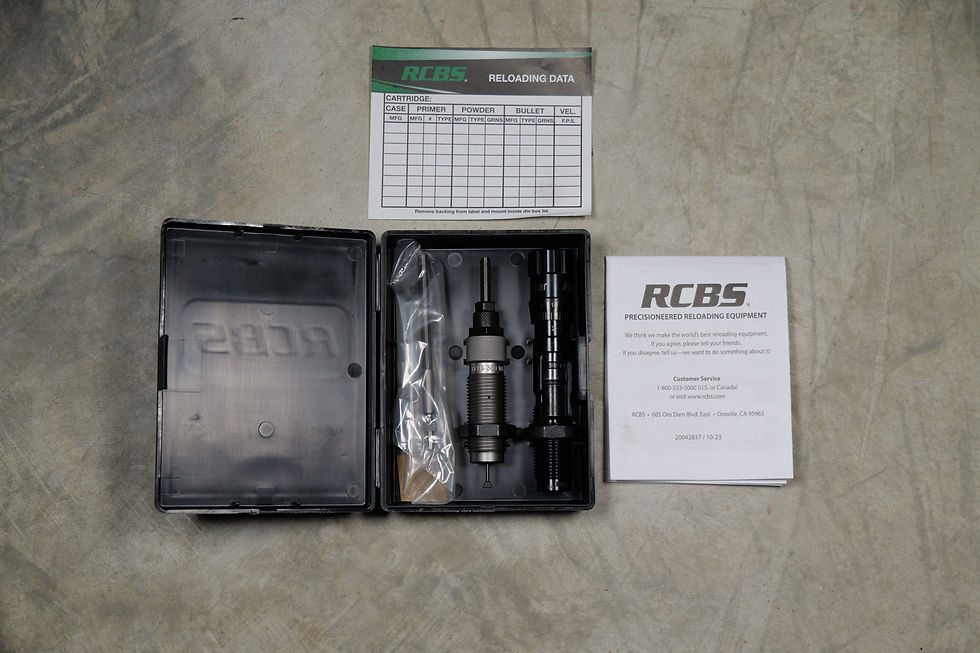Do I Measure by O.A.L or Ogive?
- Reloading_allday

- Nov 2, 2018
- 7 min read
Updated: May 21, 2025
Do I measure by O.A.L or Ogive? the answer is....it's complicated. Let's break this down and explain the parameters.
What is the overall length of a cartridge?
O.A.L and C.O.A.L are the same, in which it defines the cartridge measurement from being at the base of the case to the tip of the projectile. O.A.L stands for Overall Length, while C.O.A.L stands for Cartridge Overall Length. You can find these two used interchangeably in load manuals. Furthermore, your C.O.A.L used in relation to seating depth can drastically change your accuracy and pressure.
To water down that last sentence for the new guys, Bergerbullets.com had a great explanation,
"The primary effect of loading a cartridge long is that it leaves more internal volume inside the cartridge. This extra internal volume has a well-known effect; for a given powder charge, there will be less pressure and less velocity produced because of the extra empty space. Another way to look at this is you have to use more powder to achieve the same pressure and velocity when the bullet is seated out long.
In fact, the extra powder you can add to a cartridge with the bullet seated long will allow you to achieve greater velocity at the same pressure than a cartridge with a bullet seated short."

"When you think about it, it makes good sense. After all, when you seat the bullet out longer and leave more internal case volume for powder, you’re effectively making the cartridge into a bigger cartridge by increasing the size of the combustion chamber. Figure 1 illustrates the extra volume that’s available for powder when the bullet is seated out long.
Before concluding that it’s a good idea to start seating your bullets longer than SAAMI spec length, there are a few things to consider."- bergerbullets.com
To highlight on the few things to consider when seating your bullets father than SAMMI standards are:
1. Magazine restrictions: So, you might notice, if you are a .223 loader who uses some heavier grain projectiles in AR platforms, that the projectiles tend to be long. As a result, you will not be able to seat your bullets longer because of magazine restraints. However, if you want to single feed the projectiles individually that is definitely an option.
2. The length of your throat: The length of your throat will ultimately determine how long your projectile can be seated out. When chambered with super long projectile sticking out, you will come in contact with what is known as "lands" inside the chamber of your firearm. This is where you will meet noticeable resistance. which brings us to our main topic, Ogive.
Here are the components you will need first to perform Ogive measurements. A bullet comparator kit, a modified case to the cartridge you are reloading for, a length gauge and a set of calipers.
A quick note on the length gauge: You should get the straight gauge for bolt action rifles and the curved gauge for Ar-15 style rifles. However, I have used the straight gauge with ar-15 style rifles. It's just a bit harder.
Now that you have those tools, let's talk about using Ogive to your advantage.
C.B.T.O or commonly known as cartridge base to ogive is exactly what it sounds like. Measuring from the base of the cartridge to the "shoulder" of the projectile.
However, there are three different types of Ogive shapes: Secant, tangent, and hybrid.

Now, I want you to take a handful of your projectiles and start measuring them from the base of the projectile to the tip. You will find that they vary in length.
When manufacturers make projectiles on a massive scale, unfortunately, create defects in the meplats, or in other words, the tip of the projectile that varies in length. These variations are unwanted. Moreover, even the Ogive can be inconsistent from lot to lot...by very little though. The whole goal of handloading is making better ammo then what is available from the factory. A lot of individuals will argue that a few thousandths off doesn't really matter. However, it is completely subjective and handloading results vary from the individual users ability to handload and what application you intend on doing with your handloads.
But I digress, back to the topic.
"Which is better if projectiles are inconsistent, OAL or Ogive?"
Ogive. If you are simply reloading to SAAMI specs which is indicated in your manual—let's use .223 for this scenario—at 2.260", you are not allowing yourself to add more powder into your case. The longer the projectile is seated out of the case, it will allow you to add more powder which translates to greater velocities at the same pressure as one that is seated shorter with less powder.
The big takeaway is that since there is variation in lengths of projectiles when seating off the OAL method, you will get various amounts of seating depth. In other words, your bullet might be 0.015" off the lands, then 0.023" off the lands and so forth. New reloaders can see this most prominanelty when setting up seating dies. For example, setting the depth of bullet seating, then moving onto the second handload, to find that the bullet depth is varying from your first handload to your second. Ultimately, creating confusion for someone new thinking that something is wrong with the die itself.
However, comparators (what is used to measure OGIVE) are not alike. Insofar as, different hole diameters will result in contacting the bullet at different locations. However, as long as you are using the same comparator as you always use, you will be always receiving the same measurements.
Now that you have an idea of what OGIVE is, how do I measure it?
1. Take your modified case and your length gauge and thread them together.
2. Take the intended projectile you want to hand-load for, and place it inside the case. Make sure the inside rod of the length gauge is loose at this point so the projectile can drop into the brass case.
3. Carefully insert the modified case or fireformed case that is tapped for more consistent baseline measurements, into your barrel.
4. Start to slowly push the inside rod of the length gauge until you feel the projectile hit the lands of your rifle.
5. If the projectile get's stuck, no worries. Bump the end of your rifle on the ground and the projectile will fall out.
6. Now that you are touching the lands or jamming, tighten the screw at the end of the length gauge so it will keep track of what length you'll need. I recommend doing this a couple of times so you get an exact measurement. make sure your measurements are consistent.
7. Connect the comparator to your calipers and re-zero with the comparator gauge on them. Make sure you have the right diameter of fitting in the comparator for your diameter projectile. If you do not know which fitting to use that is provided, reference the back of the box that will tell you exactly which one to use.
8. With the modified case and projectile inserted in, measure the round with the comparator.
9. Write that length down. You will then subtract from that length. "How much should I subtract from the lands?" The baseline notoriously has been 0.010”-0.020” from the lands. However, I would recommend doing a seating depth test starting .010” from the lands and working incrementally further away, similar to a ladder test if using a secant ogive, whichever you prefer. To address other questions, if you find that touching or jamming into your lands is 3.007", you will subtract from that number.
For example: You want 0.020" off your lands, you will subtract from 3.007".....3.007"-0.020"
10. make a seating depth ladder test and shoot! It would be wise to shoot a lot of groups at a specific depth, you might initially determine to be the best, when conducting a seating depth test. Once you pick a specific depth out, shoot a lot of groups.
As always, shoot straight, be safe, and happy reloading!

Blake has been writing reloading articles for three years and helping out within the community to further enhance reloading education. In his free time, he works within the community to help out new hand-loaders by educating them on the many variables that come with this wonderful hobby. His passion is solely based on educating others so that they may pass on that information to future generations, keeping the art of hand-loading alive.
Disclaimer: The content you are about to read is for demonstration purposes only. This includes videos, blog posts, articles, and all information associated with this website. Do not attempt anything you see on this website. Again, these are for demonstration purposes only. If you see reloading data and or comments, please refer to the manufacturer of your choice and contact a technician. We are not responsible for any false data or comments from individuals. Again, this is a demonstration for reloading. Please contact or take classes from certified reloading instructors or contact the manufacturer of your choice. Please, do not attempt to tamper or modify with ammunition or firearms. Seek out a licensed professional or gunsmith. Any information you watch or read on this website must be assumed to have an error and should not be performed. Reloadingallday will not and cannot be held responsible for harm caused to readers and watchers. The material that is covered is for demonstration purposes only. Please be aware that hand-loading and other topics covered are very dangerous and you are within full responsibility and liability for your own actions. Reloadingallday is also not responsible or liable for any damage that might be caused due to those who enter this website and read any of our material or watch. Again, this is for demonstration purposes only. By reading this article, you are agreeing that you are responsible for yourself, everyone around you, watchers, viewers, commenters, and fans. You are also agreeing that you are responsible for the safety and property as follows: yourself, everyone around you, watchers, viewers, commentators, and fans. Also, you are accepting that you agree with everything this disclaimer has written down.
Keep in mind that we may receive commissions when you click our links and make purchases. However, this does not impact our reviews and comparisons. We try our best to keep things fair and balanced, in order to help you make the best choice for you.




This is a very informative post. Will there be a post or is there one on how properly bump the shoulder back a certain amount?